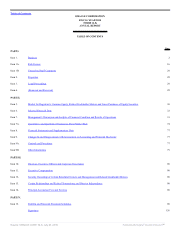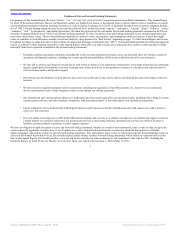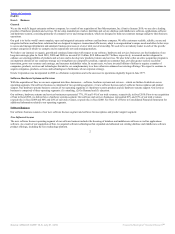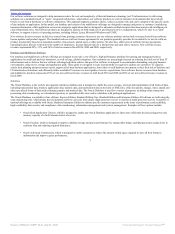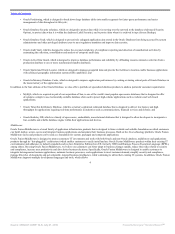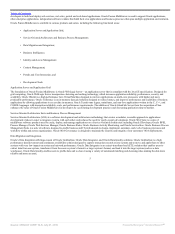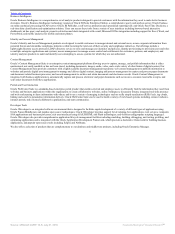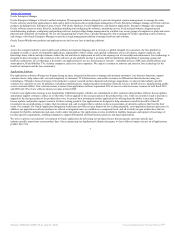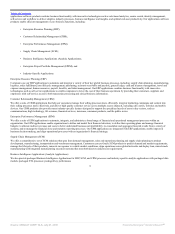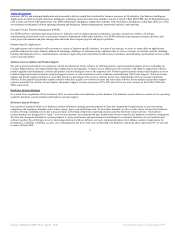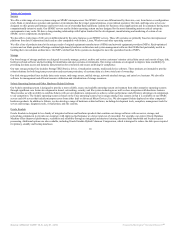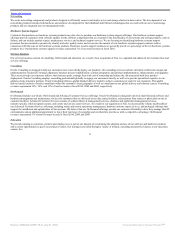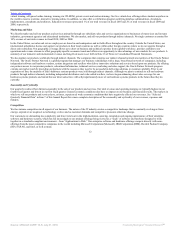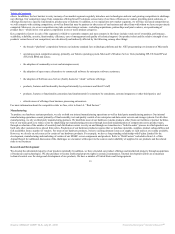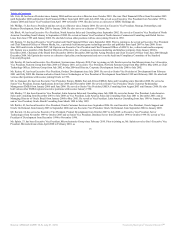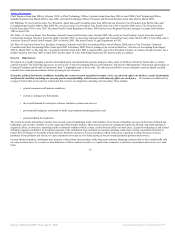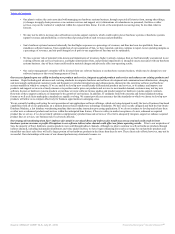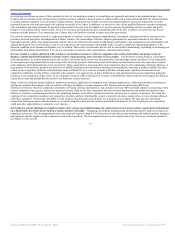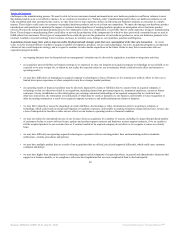Oracle 2009 Annual Report Download - page 14
Download and view the complete annual report
Please find page 14 of the 2009 Oracle annual report below. You can navigate through the pages in the report by either clicking on the pages listed below, or by using the keyword search tool below to find specific information within the annual report.
Table of Contents
Servers
We offer a wide range of server systems using our SPARC microprocessor. Our SPARC servers are differentiated by their size, cost, form factor or configuration
(rack, blade or stand-alone systems) and customer environments that they target (general purpose or specialized systems). Our mid- and large-size servers are
designed to offer greater performance and lower total cost of ownership than mainframe systems for business critical applications and for customers having more
computationally intensive needs. Our SPARC servers run the Solaris operating system and are designed for the most demanding mission critical enterprise
environments at any scale. We have a long-standing relationship with Fujitsu Limited for the development, manufacturing and marketing of certain of our
SPARC server components and products.
We also offer a wide range of x86 servers differentiated by the same features as our SPARC servers. These x86 systems are primarily based on microprocessor
platforms from Intel Corporation (Intel) and are also compatible with Solaris, Linux, Windows and other operating systems.
We offer a line of products aimed at the unique needs of original equipment manufacturers (OEMs) and network equipment providers (NEPs). Rack-optimized
systems and our blade product offerings combine high-density hardware architecture and system management software that OEMs find particularly useful in
building their own solution architectures. Our NEP-certified Sun Netra systems are designed to meet the specialized needs of NEPs.
Storage
Our broad range of storage products are designed to securely manage, protect, archive and restore customers’ mission critical data assets and consist of tape, disk,
hardware-related software and networking for mainframe and open systems environments. Our storage solutions are designed to improve data availability by
providing fast data access and dynamic data protection for restoration and secure archiving for compliance.
Our tape storage product line includes StorageTEK libraries, drives, virtualization systems, media and device software. These products are intended to provide
robust solutions for both long-term preservation and near-term protection, of customer data at a lower total cost of ownership.
Our disk storage product lines include data center arrays, mid-range arrays, unified storage, network attached storage, and entry level systems. We also offer
software for management and efficient resource utilization and virtualization of storage resources.
Solaris Operating System and Other Hardware-Related Software
Our Solaris operating system is designed to provide a more reliable, secure and scalable operating system environment than other enterprise operating systems
through significant core feature development in kernel, networking, security, and file system technologies as well as close integration with hardware features.
This provides us with an ability to combine Solaris with our own hardware components to achieve certain performance and efficiency advantages in comparison
to our competitors. The Solaris operating system is based on the Unix operating system, but is unique among Unix systems in that it is available on our SPARC
servers and x86 servers that include microprocessors from either Intel or Advanced Micro Devices, Inc. We also support Solaris deployed on other companies’
hardware products. In addition to Solaris, we also develop a range of hardware-related software, including development tools, compilers, management tools for
servers and storage, diagnostic tools, virtualization, and file systems.
Oracle Exadata
Oracle Exadata is designed to be a family of integrated software and hardware products that combine our storage software with our server, storage, and
networking components to provide our customers with improved performance at a lower total cost of ownership. For example, our current Oracle Database
Machine offers improved performance, scalability and reliability through an integrated architecture featuring increased data bandwidth and localized query
processing. Additional options are also available, including Oracle Exadata Hybrid Columnar Compression, which is designed to reduce the disk space required
for primary, standby and backup databases.
10
Source: ORACLE CORP, 10-K, July 01, 2010 Powered by Morningstar® Document Research℠


